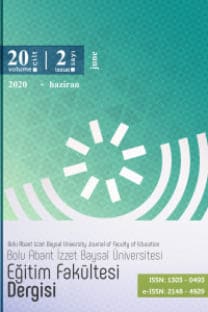MESLEKİ KARAR ENVANTERİ FAKTÖR YAPISINA AİT FARKLI ÖLÇME MODELLERİNİN DOĞRULAYICI FAKTÖR ANALİZİ İLE İNCELENMESİ
Mesleki karar, doğrulayıcı faktör analizi, ikinci düzey, iki-faktör(bi-faktör)
___
- Alpar, R. (2017). Uygulamalı çok değişkenli istatistiksel yöntemler. Ankara: Detay Yayıncılık.
- Beaujean, A.A., Parkin, J., & Parker, S. (2014). Comparing Cattell-Horn-Carroll factor models: Differences between bifactor and higher order factor models in predicting language achievement. Psychological. Assessment, 26(3), 789–805.
- Benson, N., Hulac, D.M., & Bernstein, J.D. (2013). An independent confirmatory factor analysis of the Wechsler Intelligence Scale for Children—Fourth Edition (WISC-IV) Integrated: What do the process approach subtests measure? Psychological Assessment, 25(3), 692–705.
- Bentler, P. M. & Chou, C. P. (1987). Practical issues in structural equation modeling. Sociological Methods and Research, 16(1), 78–117.
- Boomsma, A., & Hoogland, J. J. (2001). The robustness of LISREL modeling revisited. In R. Cudeck, S. du Toit, & D. Sörbom (Eds.), Structural equation models: Present and future. A Festschrift in honor of Karl Jöreskog (pp. 139–168), Chicago: Scientific Software.
- Brown, T. A. (2015). Confirmatory factor analysis for applied research. The Guilford Press: New York London. Byrne, B. M. (1998). Structural equation modelling with LISREL, PRELIS, and SIMPLIS: basic concepts, applications, and programming. Mahwah, NJ: L. Erlbaum.
- Canivez, G. L. (2016). Bifactor modeling in construct validation of multifactored tests: Implications for multidimensionality and test interpretation. In K. Schweizer & C.
- DiStefano (Eds.), Principles and methods of test construction: Standards and recent advancements (pp. 247–271). Gottingen, Germany: Hogrefe.
- Cucina, J. & Byle, K. (2017). The bifactor model fits better than the higher-order model in more than 90% of comparisons for mental abilities test batteries. Journal of Intelligence, 5(3), 27.
- Çakir, M. A. (2004). Mesleki karar envanterinin geliştirilmesi [The development of career decision inventory]. Ankara Üniversitesi Eğitim Bilimleri Fakültesi Dergisi, 37(2), 1-14.
- Flores-Kanter, P. E., Dominguez-Lara, S., Trógolo, M. A., & Medrano, L. A. (2018). Best practices in the use of bifactor models: Conceptual grounds, fit indices and complementary indicators. Revista Evaluar, 18(3), 44-48. Retrieved March 15, 2019 from https://revistas.unc.edu.ar/index.php/revaluar
- Gignac, G. E. (2008). Higher-order models versus direct hierarchical models: g as superordinate or breadth factor? Psychology Science, 50(1), 21–43.
- Gignac, G.E. (2016). The higher-order model imposes a proportionality constraint: That is why the bifactor model tends to fit better. Intelligence, 55, 57–68.
- Gignac, G.E. & Watkins, M.W. (2013). Bifactor modeling and the estimation of model-based reliability in the WAIS-IV. Multivariate Behavioral Research, 48(5), 639–662.
- Hair, J.F., Black, W. C., Barry, J.B., & Anderson, R.E. (2014). Multivariate data analysis. (Seventh edition, Pearson new international edition). Harlow: Pearson Education Limited.
- Hooper, D., Coughlan, J., & Mullen, M. (2008). Structural equation modeling: Guidelines for determining model fit. Electronic Journal of Business Research Methods, 6(1), 53-60.
- Hu, L.T. & Bentler, P. M. (1999). Cutoff criteria for fit indexes in covariance structure analysis: Conventional criteria versus new alternatives. Structural Equation Modeling: A Multidisciplinary Journal, 6(1), 1-55. http:l/doi.org/10.1080/10705519909540118
- Jackson, D. L. (2001). Sample size and number of parameter estimates in maximum likelihood confirmatory factor analysis: A Monte Carlo investigation. Structural Equation Modeling, 8(2), 205–223.
- Jöreskog, K. & Sörbom, D. (1993). LISREL 8: Structural equation modeling with the SIMPLIS command language. Chicago, IL: Scientific Software International Inc.Kline, B.R. (2005, 2015). Principles and practice of structural modeling. New York-London: The Guilford Press.
- Meydan, C. H. & Şeşen, H. (2015). Yapısal eşitlik modellemesi AMOS uygulamaları. Ankara: Seçkin Yayıncılık
- Moshagen, M. & Musch, J. (2014). Sample size requirements of the robust weighted least squares estimator. Methodology, 10(2), 60–70.
- Murray, A. L. & Johnson, W. (2013). The limitations of model fit in comparing the bi-factor versus higher-order models of human cognitive ability structure. Intelligence, 41(5), 407–422.
- Worthington, R. L., & Whittaker, T. A. (2006). Scale development research: A content analysis and recommendations for best practices. The Counseling Psychologist, 34(6), 806-838.
- Reise, S. P. (2012). The rediscovery of bifactor measurement models. Multivariate Behavioral Research, 47(5), 667–696. http://dx.doi.org/10 .1080/00273171.2012.715555
- Reise, S. P., Kim, K. H., Mansolf, M., & Widaman, K. F. (2016). Is the bifactor model a better model or is it just better at modeling implausible responses? Application of iteratively reweighted least squares to the Rosenberg Self- Esteem Scale. Multivariate Behavioral Research, 51(6):818-838.
- Rodriguez, A., Reise, S. P., & Haviland, M. G. (2016). Applying bifactor statistical indices in the eval¬uation of psychological measures. Journal of Personality Assessment, 98(3), 223-237. doi: 10.1080/00223891.2015.1089249
- Schermelleh-Engel, K., Moosbrugger, H., & Müller, H., (2003). Evaluating the fit of structural equation models: Test of significance and descriptive goodness-of-fit measures. Methods of Psychological Research - Online, 8(2), 23-74.
- Sümer, N. (2000). Yapısal eşitlik modelleri: Temel kavramlar ve örnek uygulamalar. Türk Psikoloji Yazıları, 3(6), 49-74.
- Şimşek, Ö.F. (2007). Yapısal eşitlik modellemesine giriş: Temel ilkeler ve LISREL uygulamaları. Ankara: Ekinoks Yayınları.
- Tabachnick, B.G. & Fidell, L.S. (2001). Using multivariate statistics. New York: Allyn &Bacon Inc.
- Watkins, M. W. (2010). Structure of the Wechsler Intelligence Scale for Children-fourth edition among a national sample of referred students. Psychological Assessment, 22(4), 782–787.
- ISSN: 1303-0493
- Yayın Aralığı: Yılda 4 Sayı
- Başlangıç: 2000
- Yayıncı: Abant İzzet Baysal Üniversitesi Eğitim Fakültesi
KİŞİLERARASI DUYGU DÜZENLEME ÖLÇEĞİ’NİN TÜRKÇE'YE UYARLANMASI
Vildan SARUHAN, Münevver BAŞMAN, Halil EKŞİ
KİŞİLERARASI DUYGU DÜZENLEME ÖLÇEĞİ’NİN TÜRKÇE’YE UYARLANMASI
Münevver BAŞMAN, Vildan SARUHAN, Halil EKŞİ
MOĞOL ÖĞRENCİLERİN TÜRKİYE VE TÜRKÇE ALGILARI
Halit KARATAY, Nurettin KARTALLIOĞLU
SINIF ÖĞRETMENİ ADAYLARININ MATEMATİK OKURYAZARLIĞI ÖZ-YETERLİK DÜZEYLERİNİN İNCELENMESİ
İLKOKUL ÖĞRENCİLERİNİN ÇEVRE SORUNLARI İLE İLGİLİ KAVRAMLARA YÖNELİK ALGILARININ BELİRLENMESİ
Elif ATABEK-YİĞİT, Fatime BALKAN-KIYICI, Melike YAVUZ-TOPALOĞLU
KİŞİLERARASI DUYGU DÜZENLEME ÖLÇEĞİ’NİN TÜRKÇE'YE UYARLANMASI
Vildan SARUHAN, Münevver BAŞMAN, Halil EKŞİ
Hüseyin ARTUN, Emine GÜLSEVEN, Atilla TEMUR
BİR ÇEVRİMİÇİ ÖĞRENME ORTAMININ KULLANILMASI: BAŞLICA STRATEJİLER VE OLANAK SAĞLAYICILAR
